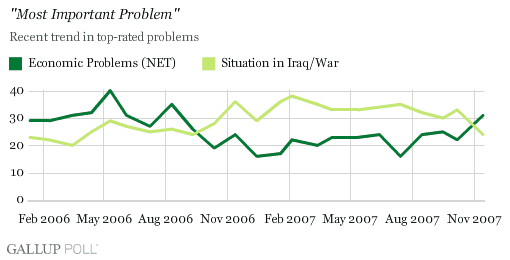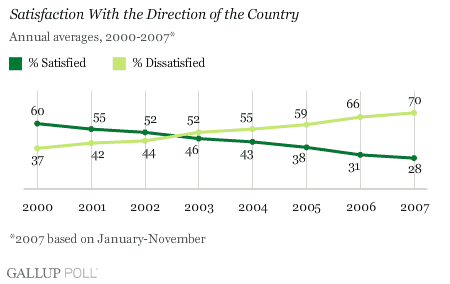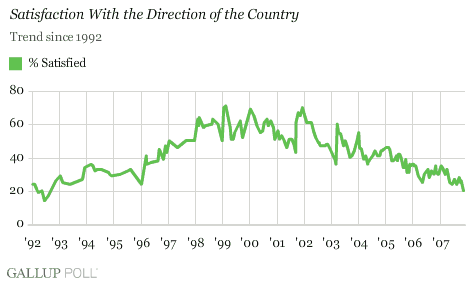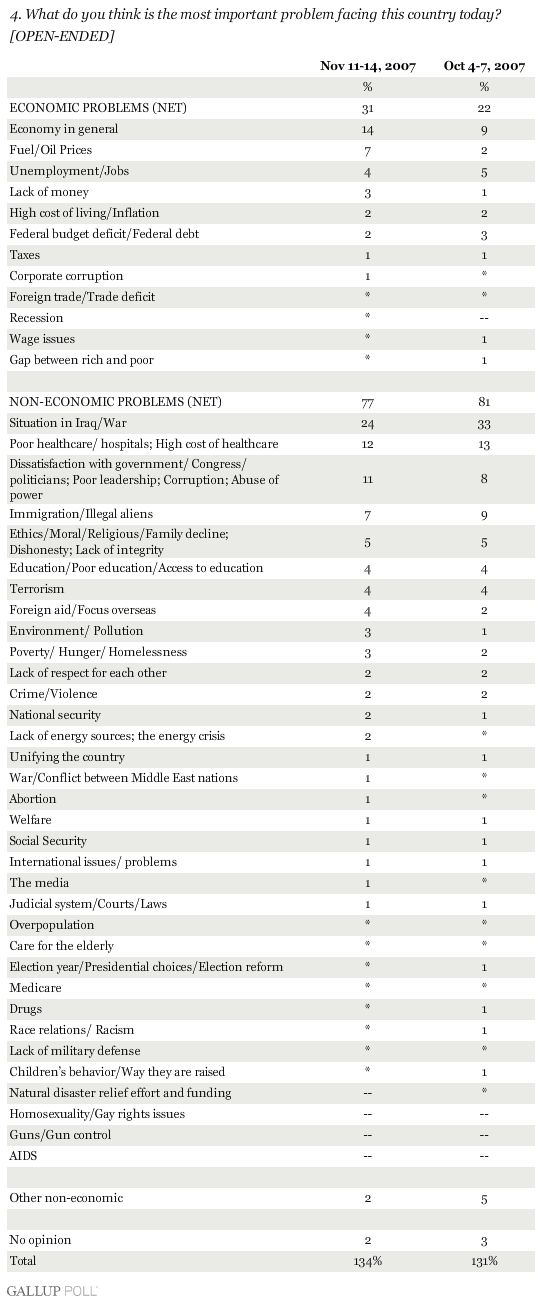PRINCETON, NJ -- As U.S. housing market and stock market troubles have intensified over the past month, Americans have grown more likely to identify the economy as the nation's top problem, and less likely to name the Iraq war. At the same time, the percentage of Americans saying they are satisfied with the way things are going in the country has dropped to the lowest level Gallup has recorded since 1992.
Gallup measures public perceptions of the nation's most important problem every month as part of the Gallup Poll Social Series. The latest survey, conducted Nov. 11-14, 2007, finds 31% of Americans citing any of several economic issues as the nation's top problem, up from 22% in October.
For the first time in more than a year, this "net economic" figure exceeds the percentage naming the situation in Iraq. Currently, 24% say Iraq is the top problem -- down from 33% in October, and the lowest percentage for Iraq seen since September 2006.

This month's rise in net economic mentions to Gallup's "Most Important Problem" measure comes mainly from five-point increases in the percentages of Americans citing the economy generally (14% today, up from 9% in October), as well as fuel prices (now 7%, up from 2%).
Other problems on the minds of at least 5% of Americans are healthcare (named by 12%), government performance and leadership (11%), immigration (7%), and ethics and morals (5%). Education, terrorism, and foreign aid are each mentioned by 4% of Americans; the environment and poverty by 3% each. Only 2% name crime. The full results are shown at the end of this report.
The poll cannot definitively answer why the economy has replaced Iraq at the top of this list. It's certainly possible that Americans perceive some improvement in the war, given recent news reports of a drop in insurgent attacks and U.S. casualties, and are thus less likely to think of Iraq as the nation's top problem. However, it's also possible that rising public concern about the economy (as documented in the new poll) is causing it to crowd out Iraq to some degree when Americans are asked to name the top problem facing the country.
Dissatisfaction Widens
Since January 2004, Americans' perceptions of the way things are going in the country have been consistently more negative than positive. However, the percentage of Americans saying they are dissatisfied has gradually increased -- from an average of 55% in 2004 to 70% in 2007.

The public's mood has become even grimmer over the past month, with the percentage dissatisfied rising from 72% in a mid-October USA Today/Gallup poll to 76% today. Only 20% of Americans are now satisfied with the way things are going in the nation, down from 26% in October, and from an average of 28% thus far in 2007.
The percentage currently saying they are satisfied with how things are going in the country (20%) is the lowest since July 1992. The lowest in Gallup's records was 12%, recorded in July 1979.

This past month's decline in public satisfaction with the way things are going might be understood in terms of consumer confidence. It comes at the same time Gallup finds Americans' already negative attitudes about the nation's economy growing even worse. Those economic attitudes, in turn, are strongly correlated with overall public satisfaction with the country's direction.
A majority of Americans who are positive about the national economy -- compared with very few of those who are negative about the economy -- say they are satisfied with the general direction of the United States. The basic relationship between these two attitudes is almost exactly the same in November as it was in October.

What's changed is that fewer Americans now fall into the "positive" and "mixed" consumer confidence categories, while there has been a nearly 10-point increase (from 57% to 66%) in those classified as "negative."

Survey Methods
Results are based on telephone interviews with 1,014 national adults, aged 18 and older, conducted Nov. 11-14, 2007. For results based on the total sample of national adults, one can say with 95% confidence that the maximum margin of sampling error is ±3 percentage points.
In addition to sampling error, question wording and practical difficulties in conducting surveys can introduce error or bias into the findings of public opinion polls.


